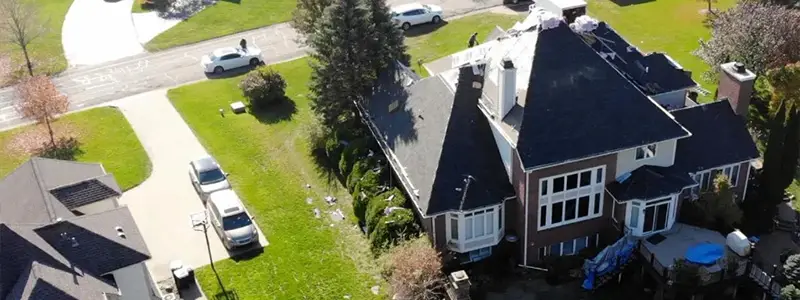Spring in Michigan brings warmer temperatures and longer days, but it also comes with severe weather that can wreak havoc on your roof. From heavy rain and high winds to hail and falling branches, spring storms can lead to serious roofing issues if not addressed promptly. In this guide, we’ll cover the top five types of spring storm damage to your roof—and what you should do to protect your home.
1. Missing or Damaged Shingles
Strong spring winds can tear, lift, or completely remove shingles from your roof. Missing shingles expose the underlayment, increasing the risk of water intrusion and structural damage. Even a few displaced shingles can compromise the integrity of your entire roofing system.
How to spot it: Look for patches where shingles are curling, cracked, or missing altogether. After a storm, check for shingle debris in your yard or gutters.
2. Hail Damage
Hail is one of the most destructive types of storm-related roof damage. These hard ice pellets can dent asphalt shingles, crack tiles, and damage flashing and vents. Over time, hail damage can lead to leaks and long-term deterioration.
How to spot it: Check for circular dents on shingles, gutters, and roof vents. Granule loss on shingles is also a common sign of hail impact.
3. Water Damage and Roof Leaks
Heavy spring rains can overwhelm weakened or compromised roofing systems. When water seeps through the roof, it can lead to mold growth, wood rot, and attic insulation damage—all of which require costly repairs if left untreated.
How to spot it: Look for water stains on ceilings or walls, damp attic insulation, or visible mold growth. A musty odor in your home may also signal hidden leaks.
4. Fallen Branches and Tree Damage
Spring storms often bring high winds that can snap tree limbs or topple entire trees. When branches fall onto your roof, they can puncture shingles, damage flashing, and even cause structural issues.
How to spot it: After a storm, visually inspect your roof for branches, punctures, or sagging areas. Contact a local roofing professional immediately if a large limb has impacted your roof.
5. Clogged or Overflowing Gutters
Storm debris like leaves, twigs, and dirt can clog your gutter system. If your gutters are blocked, water may back up onto the roof, increasing the risk of leaks, rot, and soffit damage.
How to spot it: Check for water pooling near your foundation, overflowing gutters, or debris buildup in downspouts. Keeping gutters clean is a key part of spring roof maintenance.
Don’t Let Storm Damage Go Unchecked
If you’ve experienced a recent spring storm in Southeast Michigan, it’s essential to schedule a professional roof inspection as soon as possible. Catching damage early can prevent more serious and costly problems down the line.
At Sterling Construction & Roofing, we specialize in storm damage repair and offer free roof inspections for homeowners in Livonia, West Bloomfield, and surrounding communities. We’re local, licensed, and experienced in handling all types of roofing systems, from asphalt shingles to flat commercial roofs.
Need help with roof storm damage? Contact Sterling Construction for a fast, professional evaluation.




